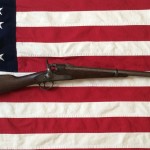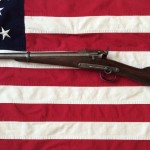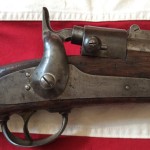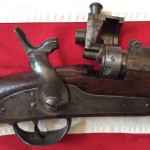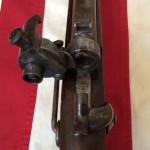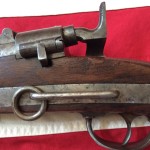- Joslyn Carbine, Model 1864
- Josyln Carbine, Saddle Ring
- Joslyn Carbine, Lock Plate
- Joslyn Carbine, Lock Plate & Breech Block
- Joslyn Carbine, Open Breech Block
- Joslyn Carbine, Cartouches
The Northern Industrial machine was ramping up in 1862. With one loss after another the Union Army was in need of not just better foot soldiers but better weapons to arm them. Procurements were being made with dozens of Northern businessmen to make as many carbines and rifles regardless of the weapons performance. Much of this changed as the war went on but in the early days of the war it was a Mecca of opportunity for anyone who had the know how and ability to make guns.
The inventor of the Joslyn was Benjamin F. Joslyn of Worcester, Massachusetts but in late 1859 William C. Freeman acquired the rights to the weapon and with the help of Senator J.L. Williams received his first Government contract. The early Joslyn carbines were percussion rifles but by October 1861 Benjamin received a patent for a rim fire design that he would implement with the Joslyn 1862 Model.
As the war raced on and there being a urgent need for as many Calvary weapons as the Union Army could purchase, Benjamin received many contracts from the U.S. Government, Ordinance Department, but he could never fill the orders as quickly as promised but it didn’t stop the Government from making contractual commitments with him.
Finally in November 1863, Benjamin after many alterations and patent changes to the Joslyn carbine received his biggest contract from the U.S. Ordnance Department. He was to furnish 15,000 Carbines at a price of $23.50 each. The order stated that the first 1000 would be delivered within 60 days and then 3000 a month until the contract was filled, however patent changes to the breech block delayed this fulfillment. Not until July of 1864 were the first carbines delivered.
The Joslyn Carbine, Model 1864 was a flawed weapon by most officers standards. It had gone through a bunch of improvements since the start of the war but still didn’t meet most evaluators expectations. Nine Officers reported test firing the Joslyn during the 1863-64 Ordnance Department survey. Only one considered it good while the others considered it either poor or worthless. The complaints on the carbine were the breechblock had a tendency to blow open while firing the weapon and there was a problem chambering the Spencer Ammunition. It seems as though the ammunition problem was faulty ammo and improper chamber tolerances for some of the Spencer ammunition.
During the coarse of the war a total of 11,261 Joslyn carbines were purchased by the U.S. Ordinance Department as well as 515,416 cartridges at a cost of $12,935. As the war came to a close there wasn’t much need for carbines, especially carbines that weren’t very good so the Joslyn Firearms Company closed its doors in 1866 and disposed of its equipment at a Sheriffs sale in June 1868.
Calvary regiments which were issued Joslyn carbines were: 4th and 8th Indiana, 1st New York Dragoons, 19th New York, 13th Tennessee, 9th Pennsylvania, 3rd West Virginia, 1st Wisconsin, 1st Nebraska, 1st Nevada and the 11th Ohio.
So that brings me to the next example in the Civil War Arsenal. This 1864 Model Joslyn has a Serial # 6620 and is in relatively good condition. With a crisp trigger mechanism and a clean stock this Josyln probably never saw much service. It has two cartouches on the left side of the stock suggesting that it was issued and likely stored in an armory after the war.
I’d like to thank John D. McAulay for his historical research and devotion. His book “Carbines of the Civil War” is a must for anyone collecting Union Carbines. This book is an easy read and great reference for Civil War weapons collectors, if you don’t own it, buy it now.
If you have any questions about this carbine or any of the other weapons in the Civil War Arsenal feel free to contact me at civilwararsenal@yahoo.com attn: Eugene West

